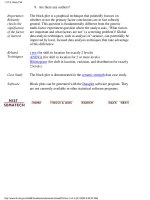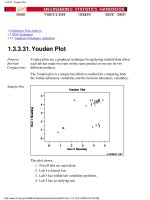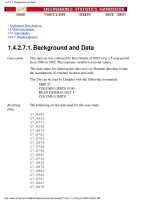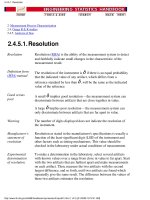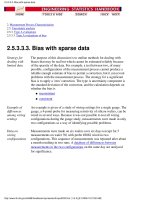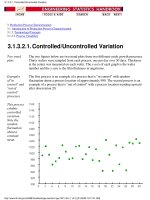Engineering Statistics Handbook Episode 4 Part 4 pps
Bạn đang xem bản rút gọn của tài liệu. Xem và tải ngay bản đầy đủ của tài liệu tại đây (119.55 KB, 18 trang )
2. Measurement Process Characterization
2.5. Uncertainty analysis
2.5.3. Type A evaluations
2.5.3.3. Type A evaluations of bias
2.5.3.3.3. Bias with sparse data
Strategy for
dealing with
limited data
The purpose of this discussion is to outline methods for dealing with
biases that may be real but which cannot be estimated reliably because
of the sparsity of the data. For example, a test between two, of many
possible, configurations of the measurement process cannot produce a
reliable enough estimate of bias to permit a correction, but it can reveal
problems with the measurement process. The strategy for a significant
bias is to apply a 'zero' correction. The type A uncertainty component is
the standard deviation of the correction, and the calculation depends on
whether the bias is
inconsistent●
consistent●
Example of
differences
among wiring
settings
An example is given of a study of wiring settings for a single gauge. The
gauge, a 4-point probe for measuring resistivity of silicon wafers, can be
wired in several ways. Because it was not possible to test all wiring
configurations during the gauge study, measurements were made in only
two configurations as a way of identifying possible problems.
Data on
wiring
configurations
Measurements were made on six wafers over six days (except for 5
measurements on wafer 39) with probe #2062 wired in two
configurations. This sequence of measurements was repeated after about
a month resulting in two runs. A database of differences between
measurements in the two configurations on the same day are analyzed
for significance.
2.5.3.3.3. Bias with sparse data
(1 of 5) [5/1/2006 10:12:52 AM]
Run software
macro for
making
plotting
differences
between the 2
wiring
configurations
A plot of the differences between the 2 configurations shows that the
differences for run 1 are, for the most part, < zero, and the differences
for run 2 are > zero. The following Dataplot commands produce the plot:
dimension 500 30
read mpc536.dat wafer day probe d1 d2
let n = count probe
let t = sequence 1 1 n
let zero = 0 for i = 1 1 n
lines dotted blank blank
characters blank 1 2
x1label = DIFFERENCES BETWEEN 2 WIRING
CONFIGURATIONS
x2label SEQUENCE BY WAFER AND DAY
plot zero d1 d2 vs t
2.5.3.3.3. Bias with sparse data
(2 of 5) [5/1/2006 10:12:52 AM]
Statistical test
for difference
between 2
configurations
A t-statistic is used as an approximate test where we are assuming the differences are
approximately normal. The average difference and standard deviation of the
difference are required for this test. If
the difference between the two configurations is statistically significant.
The average and standard deviation computed from the N = 29 differences in each
run from the table above are shown along with corresponding t-values which confirm
that the differences are significant, but in opposite directions, for both runs.
Average differences between wiring
configurations
2.5.3.3.3. Bias with sparse data
(3 of 5) [5/1/2006 10:12:52 AM]
Run Probe Average Std dev N t
1 2062 - 0.00383 0.00514 29 - 4.0
2 2062 + 0.00489 0.00400 29 + 6.6
Run software
macro for
making t-test
The following Dataplot commands
let dff = n-1
let avgrun1 = average d1
let avgrun2 = average d2
let sdrun1 = standard deviation d1
let sdrun2 = standard deviation d2
let t1 = ((n-1)**.5)*avgrun1/sdrun1
let t2 = ((n-1)**.5)*avgrun2/sdrun2
print avgrun1 sdrun1 t1
print avgrun2 sdrun2 t2
let tcrit=tppf(.975,dff)
reproduce the statistical tests in the table.
PARAMETERS AND CONSTANTS
AVGRUN1 -0.3834483E-02
SDRUN1 0.5145197E-02
T1 -0.4013319E+01
PARAMETERS AND CONSTANTS
AVGRUN2 0.4886207E-02
SDRUN2 0.4004259E-02
T2 0.6571260E+01
2.5.3.3.3. Bias with sparse data
(4 of 5) [5/1/2006 10:12:52 AM]
Case of
inconsistent
bias
The data reveal a significant wiring bias for both runs that changes direction between
runs. Because of this inconsistency, a 'zero' correction is applied to the results, and
the type A uncertainty is taken to be
For this study, the type A uncertainty for wiring bias is
Case of
consistent
bias
Even if the bias is consistent over time, a 'zero' correction is applied to the results,
and for a single run, the estimated standard deviation of the correction is
For two runs (1 and 2), the estimated standard deviation of the correction is
2.5.3.3.3. Bias with sparse data
(5 of 5) [5/1/2006 10:12:52 AM]
2. Measurement Process Characterization
2.5. Uncertainty analysis
2.5.4.Type B evaluations
Type B
evaluations
apply to both
error and
bias
Type B evaluations can apply to both random error and bias. The
distinguishing feature is that the calculation of the uncertainty
component is not based on a statistical analysis of data. The distinction
to keep in mind with regard to random error and bias is that:
random errors cannot be corrected
●
biases can, theoretically at least, be corrected or eliminated from
the result.
●
Sources of
type B
evaluations
Some examples of sources of uncertainty that lead to type B evaluations
are:
Reference standards calibrated by another laboratory
●
Physical constants used in the calculation of the reported value●
Environmental effects that cannot be sampled●
Possible configuration/geometry misalignment in the instrument●
Lack of resolution of the instrument●
Documented
sources of
uncertainty
from other
processes
Documented sources of uncertainty, such as calibration reports for
reference standards or published reports of uncertainties for physical
constants, pose no difficulties in the analysis. The uncertainty will
usually be reported as an expanded uncertainty, U, which is converted
to the standard uncertainty,
u = U/k
If the k factor is not known or documented, it is probably conservative
to assume that k = 2.
2.5.4. Type B evaluations
(1 of 2) [5/1/2006 10:12:57 AM]
Sources of
uncertainty
that are
local to the
measurement
process
Sources of uncertainty that are local to the measurement process but
which cannot be adequately sampled to allow a statistical analysis
require type B evaluations. One technique, which is widely used, is to
estimate the worst-case effect,
a, for the source of interest, from
experience
●
scientific judgment●
scant data●
A standard deviation, assuming that the effect is two-sided, can then be
computed based on a uniform, triangular, or normal distribution of
possible effects.
Following the Guide to the Expression of Uncertainty of Measurement
(GUM), the convention is to assign infinite degrees of freedom to
standard deviations derived in this manner.
2.5.4. Type B evaluations
(2 of 2) [5/1/2006 10:12:57 AM]
Standard
deviation for
a triangular
distribution
The triangular distribution leads to a less conservative estimate of
uncertainty; i.e., it gives a smaller standard deviation than the uniform
distribution. The calculation of the standard deviation is based on the
assumption that the end-points, ± a, of the distribution are known and
the mode of the triangular distribution occurs at zero.
Standard
deviation for
a normal
distribution
The normal distribution leads to the least conservative estimate of
uncertainty; i.e., it gives the smallest standard deviation. The calculation
of the standard deviation is based on the assumption that the end-points,
± a, encompass 99.7 percent of the distribution.
Degrees of
freedom
In the context of using the Welch-Saitterthwaite formula with the above
distributions, the degrees of freedom is assumed to be infinite.
2.5.4.1. Standard deviations from assumed distributions
(2 of 2) [5/1/2006 10:12:58 AM]
Exact formula Goodman (1960) derived an exact formula for the variance between two products.
Given two random variables, x and y (correspond to width and length in the above
approximate formula), the exact formula for the variance is:
with
X = E(x) and Y = E(y) (corresponds to width and length, respectively, in the
approximate formula)
●
V(x) = variance of x and V(y) = variance Y (corresponds to s
2
for width and
length, respectively, in the approximate formula)
●
E
ij
= {( x)
i
, ( y)
j
} where x = x - X and y = y - Y●
●
To obtain the standard deviation, simply take the square root of the above formula.
Also, an estimate of the statistic is obtained by substituting sample estimates for the
corresponding population values on the right hand side of the equation.
Approximate
formula
assumes
indpendence
The approximate formula assumes that length and width are independent. The exact
formula assumes that length and width are not independent.
Disadvantages
of
propagation
of error
approach
In the ideal case, the propagation of error estimate above will not differ from the
estimate made directly from the area measurements. However, in complicated scenarios,
they may differ because of:
unsuspected covariances
●
disturbances that affect the reported value and not the elementary measurements
(usually a result of mis-specification of the model)
●
mistakes in propagating the error through the defining formulas●
Propagation
of error
formula
Sometimes the measurement of interest cannot be replicated directly and it is necessary
to estimate its uncertainty via propagation of error formulas (Ku). The propagation of
error formula for
Y = f(X, Z, )
a function of one or more variables with measurements, X, Z, gives the following
estimate for the standard deviation of Y:
where
2.5.5. Propagation of error considerations
(2 of 3) [5/1/2006 10:12:59 AM]
is the standard deviation of the X measurements●
is the standard deviation of Z measurements●
is the standard deviation of Y measurements●
is the partial derivative of the function Y with respect to X, etc.●
is the estimated covariance between the X,Z measurements●
Treatment of
covariance
terms
Covariance terms can be difficult to estimate if measurements are not made in pairs.
Sometimes, these terms are omitted from the formula. Guidance on when this is
acceptable practice is given below:
If the measurements of X, Z are independent, the associated covariance term is
zero.
1.
Generally, reported values of test items from calibration designs have non-zero
covariances that must be taken into account if Y is a summation such as the mass
of two weights, or the length of two gage blocks end-to-end, etc.
2.
Practically speaking, covariance terms should be included in the computation
only if they have been estimated from sufficient data. See Ku (1966) for guidance
on what constitutes sufficient data.
3.
Sensitivity
coefficients
The partial derivatives are the sensitivity coefficients for the associated components.
Examples of
propagation
of error
analyses
Examples of propagation of error that are shown in this chapter are:
Case study of propagation of error for resistivity measurements●
Comparison of check standard analysis and propagation of error for linear
calibration
●
Propagation of error for quadratic calibration showing effect of covariance terms●
Specific
formulas
Formulas for specific functions can be found in the following sections:
functions of a single variable●
functions of two variables●
functions of many variables●
2.5.5. Propagation of error considerations
(3 of 3) [5/1/2006 10:12:59 AM]
Approximation
could be
seriously in
error if n is
small
Not directly
derived from
the formulas
Note: we need to assume that the original
data follow an approximately normal
distribution.
2.5.5.1. Formulas for functions of one variable
(2 of 2) [5/1/2006 10:13:02 AM]
Note: this is an approximation. The exact result could be
obtained starting from the exact formula for the standard
deviation of a product derived by Goodman (1960).
2.5.5.2. Formulas for functions of two variables
(2 of 2) [5/1/2006 10:13:03 AM]
Example from
fluid flow of
non-linear
function
For example, discharge coefficients for fluid flow are computed from the
following equation (Whetstone et al.)
where
Representation
of the defining
equation
The defining equation is input as
Cd=m(1 - (d/D)^4)^(1/2)/(K d^2 F p^(1/2)
delp^(1/2))
Mathematica
representation
and is represented in Mathematica as follows:
Out[1]=
4
d
Sqrt[1 - ] m
4
D
2
d F K Sqrt[delp] Sqrt[p]
2.5.5.3. Propagation of error for many variables
(2 of 4) [5/1/2006 10:13:04 AM]
Partial
derivatives -
first partial
derivative with
respect to
orifice
diameter
Partial derivatives are derived via the function D where, for example,
D[Cd, {d,1}]
indicates the first partial derivative of the discharge coefficient with respect
to orifice diameter, and the result returned by Mathematica is
Out[2]=
4
d
-2 Sqrt[1 - ] m
4
D
-
3
d F K Sqrt[delp] Sqrt[p]
2 d m
4
d 4
Sqrt[1 - ] D F K Sqrt[delp] Sqrt[p]
4
D
First partial
derivative with
respect to
pressure
Similarly, the first partial derivative of the discharge coefficient with respect
to pressure is represented by
D[Cd, {p,1}]
with the result
Out[3]=
4
d
- (Sqrt[1 - ] m)
2.5.5.3. Propagation of error for many variables
(3 of 4) [5/1/2006 10:13:04 AM]
4
D
2 3/2
2 d F K Sqrt[delp] p
Comparison of
check
standard
analysis and
propagation of
error
The software can also be used to combine the partial derivatives with the
appropriate standard deviations, and then the standard deviation for the
discharge coefficient can be evaluated and plotted for specific values of the
secondary variables.
2.5.5.3. Propagation of error for many variables
(4 of 4) [5/1/2006 10:13:04 AM]
Sensitivity
coefficients for
type A
components of
uncertainty
This section defines sensitivity coefficients that are appropriate for
type A components estimated from repeated measurements. The
pages on type A evaluations, particularly the pages related to
estimation of repeatability and reproducibility components, should
be reviewed before continuing on this page. The convention for the
notation for sensitivity coefficients for this section is that:
refers to the sensitivity coefficient for the repeatability
standard deviation,
1.
refers to the sensitivity coefficient for the reproducibility
standard deviation,
2.
refers to the sensitivity coefficient for the stability
standard deviation,
3.
with some of the coefficients possibly equal to zero.
Note on
long-term
errors
Even if no day-to-day nor run-to-run measurements were made in
determining the reported value, the sensitivity coefficient is
non-zero if that standard deviation proved to be significant in the
analysis of data.
Sensitivity
coefficients for
other type A
components of
random error
Procedures for estimating differences among instruments, operators,
etc., which are treated as random components of uncertainty in the
laboratory, show how to estimate the standard deviations so that the
sensitivity coefficients = 1.
Sensitivity
coefficients for
type A
components for
bias
This Handbook follows the ISO guidelines in that biases are
corrected (correction may be zero), and the uncertainty component
is the standard deviation of the correction. Procedures for dealing
with biases show how to estimate the standard deviation of the
correction so that the sensitivity coefficients are equal to one.
2.5.6. Uncertainty budgets and sensitivity coefficients
(2 of 3) [5/1/2006 10:13:04 AM]
Sensitivity
coefficients for
specific
applications
The following pages outline methods for computing sensitivity
coefficients where the components of uncertainty are derived in the
following manner:
From measurements on the test item itself1.
From measurements on a check standard2.
From measurements in a 2-level design3.
From measurements in a 3-level design4.
and give an example of an uncertainty budget with sensitivity
coefficients from a 3-level design.
Sensitivity
coefficients for
type B
evaluations
The majority of sensitivity coefficients for type B evaluations will
be one with a few exceptions. The sensitivity coefficient for the
uncertainty of a reference standard is the nominal value of the test
item divided by the nominal value of the reference standard.
Case
study-sensitivity
coefficients for
propagation of
error
If the uncertainty of the reported value is calculated from
propagation of error, the sensitivity coefficients are the multipliers
of the individual variance terms in the propagation of error formula.
Formulas are given for selected functions of:
functions of a single variable1.
functions of two variables2.
several variables3.
2.5.6. Uncertainty budgets and sensitivity coefficients
(3 of 3) [5/1/2006 10:13:04 AM]
To improve
the
reliability of
the
uncertainty
calculation
If possible, the measurements on the test item should be repeated over M
days and averaged to estimate the reported value. The standard deviation
for the reported value is computed from the daily averages>, and the
standard deviation for the temporal component is:
with degrees of freedom where are the daily averages
and
is the grand average.
The sensitivity coefficients are: a
1
= 0; a
2
= .
Note on
long-term
errors
Even if no day-to-day nor run-to-run measurements were made in
determining the reported value, the sensitivity coefficient is non-zero if
that standard deviation proved to be significant in the analysis of data.
2.5.6.1. Sensitivity coefficients for measurements on the test item
(2 of 2) [5/1/2006 10:13:06 AM]
